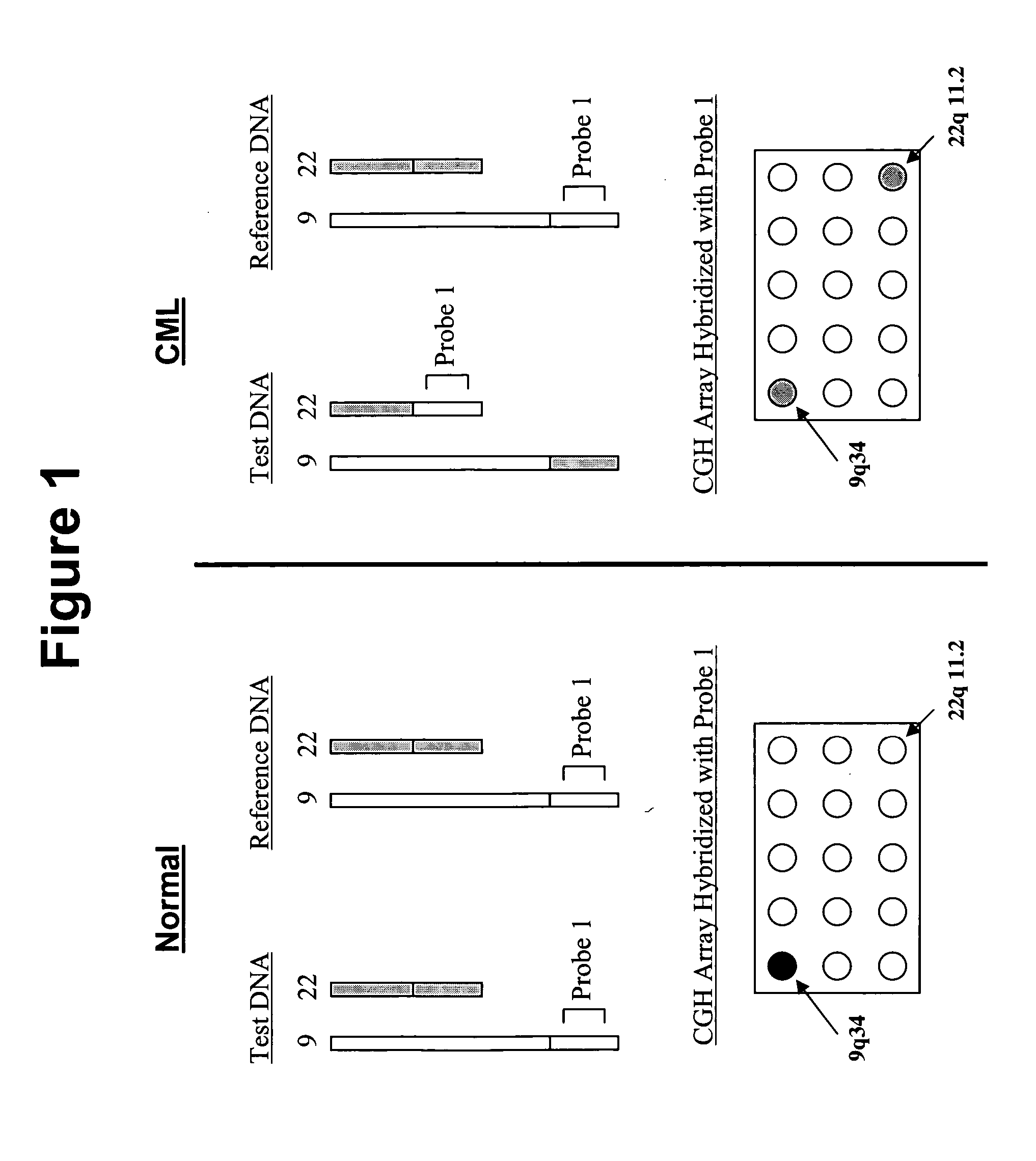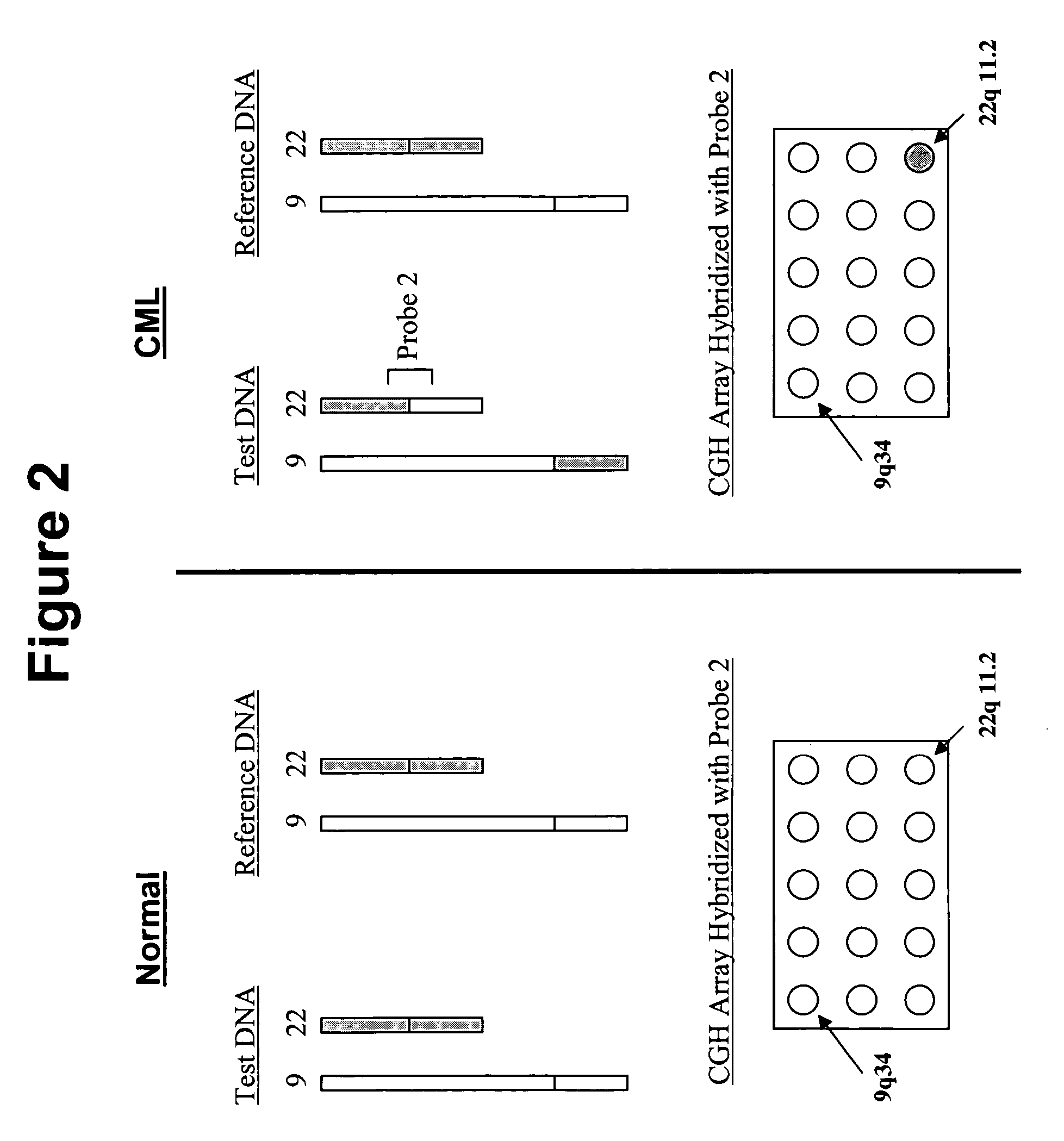Balanced translocation in comparative hybridization
- Summary
- Abstract
- Description
- Claims
- Application Information
AI Technical Summary
Benefits of technology
Problems solved by technology
Method used
Image
Examples
example 1
Preparation of a Genomic Nucleic Acid Array
[0202] A variety of microarray equipment (e.g., BioRobotics Microgrid and others; collectively “arrayers”) are available for printing genomic nucleic acid material onto a plurality of discrete locations of a solid surface. Two specific surfaces were printed with native BAC DNA to establish a protocol for the specific application of large-insert clone microarray fabrication (e.g., BACs, PACs, cosmids).
[0203] Typical prior art arrayer installation and validation protocols assess the printing performance of an arrayer using either dye-only solutions or dye-oligo DNA solutions. These conditions do not reflect the fluid dynamics associated with large clone array manufacturing and hence are sub-optimal for generating printing parameters. The present example described herein establishes a simple and qualitative approach to validating arrayers and establishing printing parameters for large insert clone microarray fabrication.
[0204] A sample coll...
example 2
Preparation of Genomic Nucleic Acids
[0206] Labeling. Genomic DNA may be labeled by any standard protocol to incorporate a detectable label. An exemplary random priming with a fluorophore is as follows. In a 100 μl reaction containing 1 ng to 1 μg DNA, combine 1× random primers solution (BioPrime DNA Labeling System, Gibco BRL), 1 mM Tris, pH 7.6, 0.1 mM EDTA, 0.2 mM each of dATP, dTTP and dGTP, 0.1 mM dCTP, 0.4 mM Cy3 or Cy5-dCTP (Amersham) and 160 U Klenow fragment (BioPrime DNA Labeling System, Gibco BRL). The DNA and random primers solution is incubated at 100° C. for 10 minutes in a total volume of 84 μl, prior to adding the other reagents, and then the final 100 μl reaction is incubated overnight at 37° C. Unincorporated nucleotides are removed using a Sephadex G-50 column.
[0207] Dendrimeric labeling. Genomic DNA may contain a tag contained within a dendrimeric construct. A dendrimer is a highly branched molecule created to integrate multiple copies of the desired detectable ...
example 3
[0209] Comparative Genomic Hybridization
[0210] Genomic nucleic acids obtained from a test sample and a reference sample, each population containing a unique capture sequence, are combined (about 1-2 μg each) with Cot-1 DNA (80-100 μg) and precipitated with ethanol. Precipitate is collected by centrifugation and allowed to air dry for 10 minutes before re-dissolving it in a 50 μl hybridization mixture containing 50% formamide, 2×SSC, 10% dextran sulfate, 4% SDS and 500 μg yeast tRNA, pH 7. The hybridization mixture is incubated at 70° C. for 10-15 minutes to denature the DNA and subsequently at 37° C. for 60 minutes to allow blocking of repetitive sequences. To the array is added 50 μl of slide blocking solution containing 500 μg salmon sperm DNA in 50% formamide, 2×SSC, 10% dextran sulfate and 4% SDS, pH 7. After a 30 minute incubation at room temperature, approximately three-quarters of the blocking solution is removed, and the denatured and re-annealed hybridization mixture is ad...
PUM
| Property | Measurement | Unit |
|---|---|---|
| Length | aaaaa | aaaaa |
Abstract
Description
Claims
Application Information
 Login to View More
Login to View More - R&D
- Intellectual Property
- Life Sciences
- Materials
- Tech Scout
- Unparalleled Data Quality
- Higher Quality Content
- 60% Fewer Hallucinations
Browse by: Latest US Patents, China's latest patents, Technical Efficacy Thesaurus, Application Domain, Technology Topic, Popular Technical Reports.
© 2025 PatSnap. All rights reserved.Legal|Privacy policy|Modern Slavery Act Transparency Statement|Sitemap|About US| Contact US: help@patsnap.com


